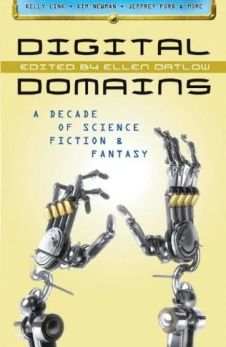
Title: Frankenstein’s Daughter
Author: Maureen McHugh
Date of First Publication: 2 April 2003
Place of Publication: Sci Fiction, Ed. Ellen Datlow (SciFi.com)
Type: Short story
Themes: FRANKENSTEIN MONSTER; SYMPATHETIC MONSTER
Critical Summary: “Frankenstein’s Daughter” introduces a family that has been broken up by the accidental death of their deceased child, Kelsey. Surviving Kelsey are her parents, Allan and Jenna, and Kelsey’s younger brother, Robert. After a car kills Kelsey, Jenna convinces Allan to have her cloned, a process which is illegal in the United States, but which they are able to have done in Israel, bringing her back as an adopted daughter. This child-clone, Cara, has serious medical issues, including mental retardation and respiratory problems that doctors anticipate will be fatal between ages twelve and eighteen.
The effects of the loss of their child and the difficulties of raising a clone with medical disabilities causes Allan and Jenna to divorce. Allan is now seeing a woman named Joyce, but remains supportive of his family.
Robert, their son, is a fourteen-year-old a kleptomaniac. He calls himself the “Iceman,” with a sense of pride that he can show no emotion while shoplifting. He lives with his mom and Cara, and spends time with two friends who also have a penchant for stealing. Robert decides to impress these friends by vandalizing the police station that the boys drive past on the bus en route to their school. However, he is caught spray-painting his message on the wall, and his parents must pick him up from the station. Allan decides that Robert should come live with him indefinitely because managing a household with Robert and Cara is too much for one person.
Upon leaving the police station, Allan informs Robert about the new living arrangements. Robert protests verbally and begins to run down the street, away from his parents. Although Jenna joins Allan in calling Robert back to them, watching him fight brings her joy because she sees it as an indicator that he will survive what he is running from, though it is “inescapable.”
The issue of cloning places the actual scientists/doctors, as well as Cara’s parents, into the role of “Mad Scientists.” Jenna even reflects that when she made the decision, she was not sane because of her loss. Like Victor Frankenstein, they have chosen to create life using scientific procedures, rather than natural biological means. In cloning their own dead daughter, they appear to be trying to resurrect her from the dead, as opposed to creating a whole new, separate life. However, Cara is not what they expected. The reader sees a loss of control occur when Kelsey is not reanimated in a new body, and when this new body is stricken by health conditions that will cause them to lose yet another young child.
Of course, this means that Cara is “The Creature” figure, seen as “Other” and not accepted by society, some of whom send hate mail, and who treat her and her family with a sort of curiosity afforded to celebrities and freak-shows. Even the doctors who treat her take on a different attitude when they discover she is a clone. Cara herself does not speak much in the story, being too young and delayed to impart much of substance. However, she does display emotions, and her innocence and suffering make her a sympathetic character, and, for some, a “Sympathetic Monster.”
Administrative Notes: Melanie Yogurtian, CSUF. Edited by Adriana Lora and Samuel Ortiz, CSUF
